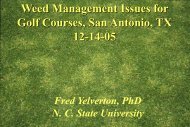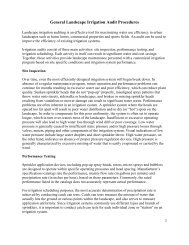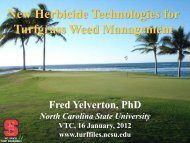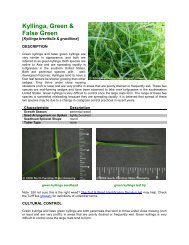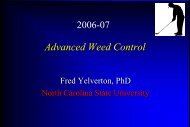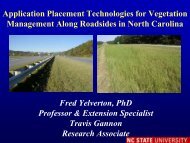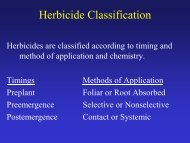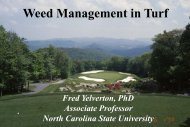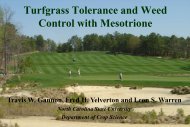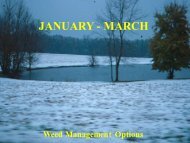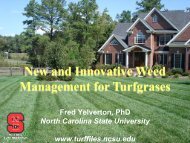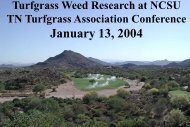Carolina Athletic Fields: - TurfFiles - North Carolina State University
Carolina Athletic Fields: - TurfFiles - North Carolina State University
Carolina Athletic Fields: - TurfFiles - North Carolina State University
- No tags were found...
Create successful ePaper yourself
Turn your PDF publications into a flip-book with our unique Google optimized e-Paper software.
available through the NC Cooperative Extension Service.Alternatively, most of this information is available on thewebsite www.turffiles.ncsu.edu.WeedsWeeds do not kill healthy turfgrass but appear when turfdensity and competitiveness decrease. However, with theextensive damage from traffic on sports fields, weeds canbecome established, and control measures are usuallynecessary.Painting a logo on a field in preparation for a game. Onlypaints formulated for use on turfgrass should be used tominimize damage to the turf.INTEGRATED PEST MANAGEMENTPeople are becoming more aware and concerned aboutthe effects of chemicals on our environment. Researchindicates that pesticide use poses a minimal threat to thehealth of humans, animals, and the environment whenused appropriately. But because we can’t be certain, manypeople choose to avoid pesticides. So how would youhandle a pest problem that is destroying the appearanceof your field? Do you use pesticides, change culturalpractices, or both?The balanced use of all available control methods iscalled Integrated Pest Management (IPM). The idea issimple. All available prevention and control methods areused to keep pests from reaching damaging levels. Pesticidesare used only when necessary.Planting the best-adapted grass and then watering,mowing, and fertilizing it properly form the basis forintegrated pest management. Keeping the turf healthyenables it to tolerate low levels of pests and makes thearea a good habitat for beneficial organisms that helpcontrol pests.If chemical control is necessary, select the safesteffective pesticide and follow label recommendations.Chemicals should be applied when the pest is mostsusceptible. Treat only those areas in need, and regardpesticides as only one of many tools available in turfcare. Integrated pest management can be successful, butmore time and labor are required and high expectationsmay not be met when pest pressures and environmentalconditions are severe.For specific weed, insect, and disease identificationand control recommendations, readers are referred to thepublications Turf Pest Management Manual and The PestControl Recommendation Guide. These publications areInsectsSeveral insects can infest sports turf including molecrickets, white grubs, fire ants, armyworms, and sodwebworms. Cultural practices such as over fertilizingwith soluble fertilizers, irregular mowing, overwatering,and thatch build-up encourage lush succulent growthwhich can lead to insect damage. The turfgrass areashould be checked weekly for insect damage. Furtherexamination for sod webworms, armyworms (infestationsalways start along the edge of the field), and molecrickets can be done by a soap flush method based oninsect life cycles. Mix one fluid ounce of dishwashingsoap in a 2-gallon sprinkling can full of water anddrench a 2 square feet area. Observe the area for severalminutes, and, if present, insects will emerge. (Theone exception is white grubs.) Follow the managementguidelines in Turf Pest Management Manual to reducethese problems.DiseasesVery few diseases pose a serious threat to athletic fieldswhen proper turfgrass management practices are followed.Spring dead spot, caused by the soil-dwellingfungus Ophiosphaerella korrae, is one disease that cancause severe damage to bermudagrass athletic fields in<strong>North</strong> <strong>Carolina</strong>. Symptoms of spring dead spot appear inthe spring as circular patches or rings, from 6 inches toseveral feet in diameter, that remain dormant as the surroundingturf greens-up. The affected turf is completelydead and eventually collapses to leave sunken depressionsthat severely detract from the safety and playabilityof an athletic field surface. Since the affected turf is completelydead, recovery from spring dead spot is very slowand may take the entire summer in severe cases.Fungicides can be used to prevent spring dead spotdevelopment. Products containing fenarimol (Rubigan)or tebuconazole (Torque) are the most effective but mustbe applied preventatively in the fall prior to the onset ofwinter dormancy. These preventive applications shouldbe watered in immediately with ¼ inch of irrigation to13



